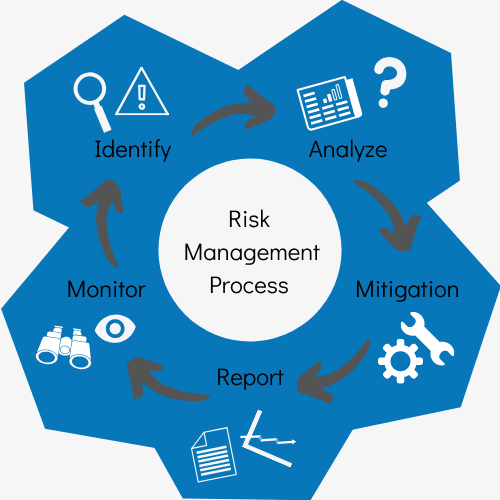The Increasing Importance of Risk Management in Medical and Safety
Wiki Article
Exploring the Significance of Risk Management for Effective Decision-Making Methods
In the elaborate world of organization, Risk Management emerges as a vital element in the decision-making process. The ability to recognize prospective hazards and possibilities, and plan appropriately, can lead to the difference in between success and failing.Understanding the Idea of Risk Management
Risk Management, an important component in decision-making, is often misinterpreted or oversimplified. Usually, it describes the identification, examination, and prioritization of risks to minimize, monitor, and regulate the likelihood or impact of unfortunate occasions. Nonetheless, it's not just concerning protecting against adverse outcomes, but additionally regarding recognizing potential possibilities. Risk Management entails organized and self-displined approaches, utilizing data and informative evaluations. It requires a detailed understanding of the organization's context, purposes, and the prospective dangers that could thwart them. From monetary unpredictabilities, lawful responsibilities, critical Management mistakes, to crashes and all-natural disasters, it deals with various threats. Significantly, effective Risk Management is not stagnant; it's a continual, progressive process that progresses with altering circumstances.The Function of Risk Management in Decision-Making Processes
In the realm of tactical preparation and service operations, Risk Management plays an important duty in decision-making processes. It aids in identifying possible hazards and uncertainties that can affect the success of service goals. By mapping these risks, firms can formulate techniques to reduce their impact, making certain business connection and security. Risk Management therefore ends up being an important device in decision-making, assisting leaders to make educated options based upon an extensive understanding of the risks included. It encourages a proactive strategy, allowing organizations to anticipate and prepare for feasible future situations. This considerably minimizes the possibility of negative repercussions, advertising more efficient and efficient decision-making techniques. For that reason, Risk Management functions as a crucial part in the decision-making processes of any organization.
Exactly How Risk Management Improves Strategic Planning
In the context of tactical preparation, Risk Management plays a pivotal duty. Starting with the recognition of prospective risks, it further reaches the implementation of Risk reduction actions. The duty of Risk Management is not static yet dynamic, as it requires continuous monitoring and adjusting of techniques.Determining Possible Risks

Carrying Out Risk Reduction
Risk reduction get more strategies can range from Risk avoidance, Risk transfer, to run the risk of reduction. Each method needs to be customized to the specific Risk, considering its possible effect and the organization's Risk tolerance. Effective Risk mitigation requires a deep understanding of the Risk landscape and the possible influence of each Risk.Tracking and Readjusting Strategies
Though Risk mitigation is a crucial step in tactical planning, constant monitoring and adjustment of these approaches is just as vital. It also provides a chance to evaluate the success of the Risk Management procedures, permitting modifications to be made where essential, further enhancing critical preparation. Surveillance and readjusting Risk Management strategies is an important component for boosting an organization's strength and tactical preparation.Instance Studies: Effective Risk Management and Decision-Making
Worldwide of service and financing, successful Risk Management and decision-making often serve as the pillars of thriving ventures. One such entity is an international oil company that alleviated financial loss by hedging versus rising and fall oil prices. In an additional circumstances, a technology start-up grew by identifying and approving high-risk, high-reward techniques in a volatile market. An international financial institution, faced with regulative uncertainties, successfully navigated the scenario through aggressive Risk analysis and dynamic decision-making. These situations highlight the value of astute Risk Management in decision-making procedures. It is not the lack of Risk, but the Management of it, that typically distinguishes successful companies from unsuccessful ones. These situations emphasize the critical duty of Risk Management in critical decision-making. importance of risk management.Tools and Techniques for Effective Risk Management
These tools, such as Risk signs up and heat maps, aid in identifying and evaluating potential risks. Risk feedback approaches, a crucial component of Risk Management, involve accepting, avoiding, transferring, or mitigating threats. With these devices and methods, decision-makers can Continue navigate the complex landscape of Risk Management, therefore assisting in notified and efficient decision-making.Future Patterns in Risk Management and Decision-Making Strategies
As we discover the vast landscape of Risk Management, it comes to be apparent that the tools and techniques utilized today will certainly continue to develop. The principle of Risk society, where every member of a company is mindful and entailed in Risk Management, will gain a lot more importance. These trends advertise an even more aggressive and inclusive strategy in the direction of Risk Management and decision-making.Conclusion

Risk Management thus ends up being an essential device in decision-making, assisting leaders to make enlightened options based on a thorough understanding of the dangers involved. Risk reduction techniques can vary from Risk evasion, Risk transfer, to run the risk of reduction (importance of risk management). Effective Risk reduction calls for a deep understanding of the Risk landscape and the prospective influence of each Risk. Risk response approaches, a crucial component of Risk Management, involve approving, my link preventing, moving, or mitigating dangers. The idea of Risk society, where every participant of an organization is aware and entailed in Risk Management, will certainly acquire much more prestige
Report this wiki page